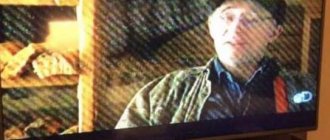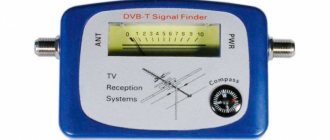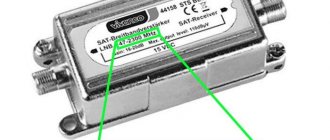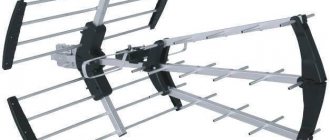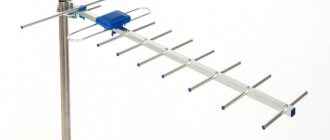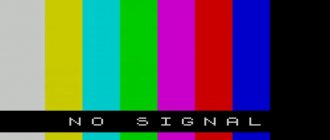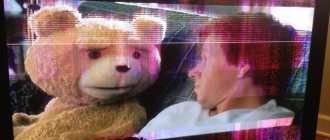The lack of signal on the TV creates significant discomfort. The cause of this problem may be technical problems, operator failures, or climatic factors. Eliminating it does not always require the help of specialists. After reading the article, you will be able to determine why there is no signal on the TV and what to do in a particular case. This will help you deal with most problems on your own.
Operator repair work
If you use television services provided by your provider, and the set-top box says there is no signal, the provider may be carrying out maintenance or repair work.
When you turn on the digital set-top box, there may be no video signal due to the usual freezing of the equipment. Restart the set-top box and check operation. If this does not help, contact support to clarify the details of the repair work. You can view other notification channels:
- Official website of the provider.
- Information line in a TV set-top box.
- Mailing about work being carried out at the appointed time.
Where to call if there is no digital television signal?
A malfunction on the repeater may well be the cause of the “no signal for digital channels” message. Remember that television transmitter infrastructure is maintained by people. They can be wrong too. Therefore, the repeater may be de-energized or the equipment may fail.
We recommend calling the CETV hotline number: 8-800-220-20-02.
For a temporary solution, you can try pointing the antenna towards another broadcast tower. You can find the tower closest to you using the digital television coverage map.
Technical damage
A common reason that there is no signal on the TV is the presence of hardware failures in the equipment connected to the TV. The most common:
- Mechanical damage to the television cable: break, damage to insulation, etc.
- Damage or deformation of the satellite dish/antenna: weather, vandalism or physical aging.
- Problems with the receiver: connector, board, firmware.
Based on the information received, it is necessary to visually examine each component and determine where the technical damage occurred.
Cable
First of all, check whether the cable plug is properly secured in the connector of the TV or set-top box. There is a possibility that weak fixation by the socket is the cause of a weak signal or its complete absence.
If the problem is in the connector, you should firmly secure the cable in it. And if this is not possible due to deformation of the connector or cable, you should re-solder the connector, strip the cable and connect it correctly.
Examine the cable along its entire length to the antenna (to the cabinet with the provider’s equipment). Check the cable for breaks, cuts, exposed insulation and other signs of cable failure. If any are identified, it is recommended to replace the cable or “cure” it using an F-socket to F-socket adapter.
If you have access to an antenna, check the quality of the coaxial cable connection to the antenna. It is important that no damage to the connectors is observed.
Antenna
Take a close look at the antenna. Pay attention to:
- The direction in which the antenna is turned (especially if the nearest repeater is tens of kilometers away). If the wind changes the orientation, try to return it to the correct position. For a satellite dish, a correctly aligned converter is important. If it moves even a fraction, the signal may disappear.
- The condition of the antenna – it may be covered in dust, dirt, snow or covered with ice, or part of it is already rusty. If possible, clean the signal receiving devices, since all these factors negatively affect the signal quality.
- The condition of the brackets and other structures on which the antenna is placed. Perhaps they no longer provide the stable position that the antenna needs.
Receiver
When checking everything else, it still says that there is no digital television signal, check if your DVB-S or DVB-T/C set-top box is letting you down.
Frequent breakdowns of the digital assistant:
- Decoder failure.
- Oxidation or burnout of contacts.
- Power supply failure.
- Failure in the internal memory (hardware or software).
Sometimes, fixing a problem with your current receiver costs more than buying a new one. Re-soldering connectors or regular flashing can pay off if the memory module fails. The remaining damage usually does not pay off, and it is easier to buy a new console.
It is advisable to flash it with native firmware, which is available on television and radio resources on the Internet. You need to select native firmware according to the model of your receiver. If the device is still supported by the developer, flash the latest stable version of the software.
Selecting a TV antenna
When digital television does not show, you need to purchase a narrowly directional outdoor antenna - a “wave channel” or a broadly directional “panel” antenna.
If the distance is up to 20 kilometers, using an antenna with a built-in amplifier is not advisable.
When purchasing, pay attention to the manufacturer. Most often, antenna equipment developers from Russia (who do not resell Chinese products) have adopted engineering experience from the USSR and are highly qualified. Therefore, the antenna corresponds to the declared characteristics and is effective. And most importantly, it is adapted to our reception conditions and operating ranges.
We recommend our rating of antennas for digital TV, which will help you choose a quality model.
It is better not to order antenna equipment on Alixpress. Even judging by the image of the Chinese antenna, one can understand that the declared characteristics in reality are 5-10 decibels lower. Not to mention the “industrial” type high-frequency cable included in the kit, which leads to a catastrophic loss of the useful signal.
Homemade antenna for digital TV. Read how to do it here.
No signal due to external factors
Weather conditions are a common enemy of an analog signal. The digital signal does not depend on bad weather, exactly until the integrity of the antenna is damaged. Because of this, the TV may experience noise, pixel loss, weak sound, and other disturbances.
For example, a strong wind can change the position of the antenna, the tilt of a dish or a satellite connector if its retaining structural element is weakened. To fix the problem after this and configure the operation of the channels:
- Slowly turn the antenna away from you and towards you, setting the direction that improves the signal quality.
- Find the optimal point at which the TV starts broadcasting high-quality image and sound.
If you need to set up a satellite dish, you should understand that buildings and tall trees can interfere with the signal, and it’s best to set up satellite connectors not at random, but using an angle calculator. Typically, a satellite calculator can be downloaded as a smartphone application or found as a web version on the Internet.
How to set up your TV after fixing it
It is not enough to simply eliminate the reason for the lack of an image, because... After this, additional display settings may be required.
Here is a list of necessary actions, depending on the nature of the malfunction:
- Instead of a faulty built-in decoder, an external digital set-top box is used. To watch, you need to switch from DVB-T2 to another channel (depending on the port, it will be AV or HDMI).
- Each matrix has its own image output properties, and when replacing it, it is necessary to change the contrast, brightness, etc.
- If a digital set-top box for an analog TV was replaced, a new search for TV channels is needed. For cheap T2 devices with 20 channels, it is better to use auto search. Functional digital receivers will need to be configured manually, following the instructions for use.
If you replaced a digital receiver with an analogue one, you need to configure TV channels - first select the signal source, and then start scanning.
In other cases, you do not need to change the settings on the TV, but they may be required for another device with which it interacts (for example, a receiver).
Smart TV software update
If you are the owner of an LG, Sony, Samsung or other popular brand marked Smart TV, the reason may lie in a software update that occurred automatically, but for some reason destroyed the channel settings.
It is possible that the update may not have installed or another error may have occurred, therefore:
- Turn off the TV and unplug it - this is very important. You need to completely unplug the device from the outlet and wait about 20-30 minutes. This instruction manual is available on almost all official websites of TV manufacturers.
- Turn on your device. Let the TV connect to the Internet.
- Use your remote control to open Settings.
- In the “Support” section, select “Software Update” and update the firmware to the latest version.
- Then go to the “Broadcast” section and check the operation of the channels. If the screen shows a black square, go to the channel selection and automatically find them again.
Final setup
After adjusting the compass and coverage map, you can try to increase the signal that appears. Display the signal strength scale and play around with the antenna. Rotate the antenna in different planes with slow movements.
Sometimes there is a delay in level updates. Therefore, you need to fix the antenna briefly in each position.
Once achieved, make the final fixation of the antenna. Poor fastening will cause the structure to change position due to strong gusts of wind, which will affect the quality of reception.
Additionally, secure the cable so that it does not dangle. Strong vibrations can cause the cable to be torn off from the antenna or the structure to shift.
Not all channels broadcast
If all of the above has been checked and done, and the output of the TV with a satellite receiver and dish produces a weak signal, and in some places there is none at all, perform the initial setup of the receiver to receive a satellite signal:
- Open the menu, select the desired satellite and frequency.
- Information about specific channels can be taken from the “info” information. This data is also available on the Internet, in the public domain.
- Afterwards, select the correct port. Typically, this is a 4-port "DiSEqC".
- If colored stripes appear (signal quality), save the settings.
- Then, set up other satellites in the same way.
If your TV loses signals from the antenna from time to time, the tuner is to blame. More precisely, a decoder that needs to be reflashed. It is important to note that decoder firmware and tuner firmware are two different things. For this purpose, it is recommended to take the tuner to a service center or replace it with a new one.
Possible faults
The experience of TV repair specialists helped to collect the main breakdowns of TVs, in which there is an image, but the sound is gone.
Power supply - from 1000 rubles.
Perhaps the capacitors are swollen, the contacts of the elements or tracks in the audio circuit are burned out.
Signs
There is no sound or disappears periodically. At the same time, the TV shows the picture.
How to fix
The power supply needs to be repaired or replaced.
TV speakers are faulty or their contacts are loose - from 1000 rubles.
The speakers fail when the volume is turned up to maximum. Contacts burn out or oxidize.
Signs
There is a picture, but no sound. If you connect headphones to the TV, sound appears in them.
How to fix
The technician checks the speakers with a multimeter and finds the cause of the problem. Failed speakers are replaced with new ones, the contacts are soldered.
ULF sound chip (low frequency amplifier - from 1300 rubles.
Responsible for transmitting sound to speakers.
Signs
When you turn it on, there is sound, and then it disappears, or there is no sound at all.
How to fix
The audio amplifier needs to be replaced.
Motherboard (main board) - from 2000 rubles.
Motherboard (main board). The most expensive part of a TV's electronics. Elements on the board burn out or tracks in the audio circuit burn out.
Signs
There is no sound at all, disappears periodically, appears only some time after turning it on, or, conversely, is present when turned on, and then disappears.
